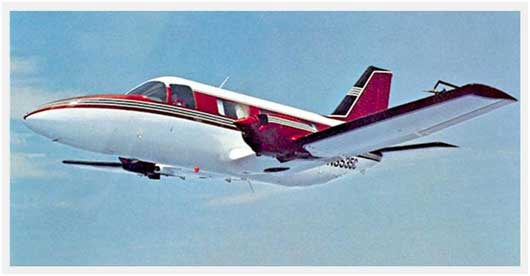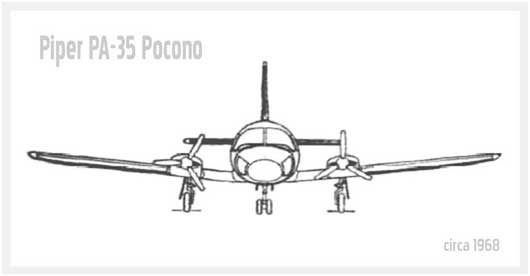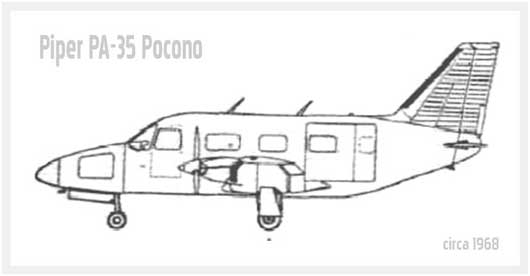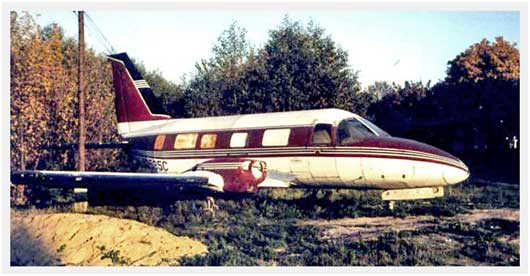1968 Piper PA-35 Pocono - Underpowered ‘Wide Body’ For 18 Souls
 Friday, November 5, 2010 at 09:41PM
Friday, November 5, 2010 at 09:41PM  The one and only Piper PA-35 Pocono - circa 1968
The one and only Piper PA-35 Pocono - circa 1968
(7 pix)
The voiceover in the PiperJet Altaire video I posted the other day said that the Altaire has “the largest cabin ever in any Piper aircraft”. Well, that might not be completely accurate… meet the Piper PA-35 Pocono.
Piper Aircraft was on the warpath in the 1960’s… after introducing the PA-23 Apache in 1954, which happened to be their first American Indian named airplane as well as their first twin, Piper was really pushing an enlarged line of twin engine aircraft. The 4-place Apache grew into the 5-place Aztec by the late 50’s, and when the 60’s began, the Aztec had been made into a 6 seat aircraft with 250hp hanging off each wing. Soon after, in 1963, the PA-30 Twin Comanche first flew, then there was the PA-31 Navajo first flight in 1964, and the PA-34 Seneca first flew in 1967. That’s a lot of development of production-bound aircraft in a relatively short period of time.
But their biggest twin-engine effort was an airplane you most likely have never heard of… the Piper PA-35 Pocono. While the other aircraft that had exited the Piper design laboratory were relatively logical extensions of other Piper projects, the Pocono was a wild departure. The intent was to provide a small airliner that would appeal to the growing number of feeder airlines. The basic concept for accomplishing this was a really wide fuselage cross section. The Pocono fuselage was seven feet wide! Umm, did you hear me? Seven feet wide! This allowed the approximately 40 foot long fuselage to be set up to carry a total of 18 souls, with the passenger cabin having three seats across, in a 1-2 configuration with an off-center isle between.
When you consider the advantage of easier CG handling by reducing the number of passengers seated well forward or well aft of the center of gravity, along with the really large loading door, the separate split airstair door up front for the cockpit crew, and the overall generally good looks, the Pocono seemed to be on a really great journey.




Where Piper seemed to miss the mark was in the powerplants. Originally built with Lycoming TIO-720 eight cylinder engines making 475 hp, the Pocono seemed almost surely destined to be under powered. A Beech 18 (Twin Beech) with two 450 hp radial engines was only good for a max of 11 bodies, so the idea that the Pocono was gonna be viable with 18 bodies seemed unlikely. It does look like the PA-35 came in with an empty weight about 1,000 pounds lighter than a Twin Beech, but more horsepower was desperately needed. Lycoming had been working to increase power output to 520 hp, and it appears Piper was really counting on that as a way to make the Pocono perform acceptably, but the engines never came to be. Plus, it would seem that there was really more of a need for something in the 700 hp range for an aircraft meant to carry so many people.
Turboprop engines were becoming a real option for aircraft designers at this time with the Pratt & Whitney PT6 having entered service in 1964. Beech introduced the Beech 99, a 15 passenger commuter type aircraft powered by 550 hp PT6’s in 1968. Later on, Beech upgraded the engines to 680 hp and then 715 hp to get better performance. Had the Pocono been designed around the PT6 from the start, things might have gone very differently. The wide fuselage cross section might have seemed more comfortable than the B99’s 2 across fuselage. Maybe Piper was really working hard to keep the cost down for their potential customers, the smallest of feeder airlines, and saw piston engines as a way to achieve that. As it turned out, those smaller airlines were having trouble making money and staying in business in the late 60’s, and when Piper couldn’t get the piston horsepower that was needed, the project was stopped.

 Lonely Pocono prototype in 1995 in Widelka, Poland (photo: wikipedia)
Lonely Pocono prototype in 1995 in Widelka, Poland (photo: wikipedia)
By 1970 Piper hinted at either a four engine version, or a turboprop version, but neither idea was advanced. In the late 70’s Piper sent the PA-35 Pocono to Poland as part of a program presumably intended to develop the airplane over there. However, nothing ever came of it. As seen in the last picture here, the prototype Pocono was spotted in the mid 90’s looking very lonely in the town of Widelka in Poland. What an interesting and sad end to a very unique aircraft. I’m not aware of the status of the airframe today, but hopefully it still exists.
So it looks like that Piperjet Altaire video was off a little... I’m pretty sure we’d have to say the Altaire has “the second largest cabin ever in any Piper aircraft” : )
 Martt |
Martt |  15 Comments |
15 Comments | 













































































Reader Comments (15)
You never cease to amaze me with your memory / ability to find the most random (but at the same time interesting) subjects...well done!
The whole time I was reading I kept thinking "what engines" and as I got to the front sketches started thinking "opposed piston...how?" No surprise it never took off. But the thought of the PT6 looms strong - with a different engine, that MIGHT have ended up being the "puddle jumpers" we all know today.
"Its [the Pocono's] epitaph was probably best written in a magazine interview with Howard 'Pug' Piper, director of Piper's Research and Development program from 1950 to 1973. 'What we should have done,' Piper said, 'is put four Aztec engines on it.' "
-- Closet Cases, Randy Mertens, 2nd ed, 1982
Adam- Thanx for the compliment... I'm glad you enjoyed a little Piper Pocono history. I find it fascinating to see the things that might have been when we look back at aviation projects from the past.
Martt- Neat article, I thought I was the only one that had been around the Pocono. Didn't get to fly it but I was in the Pocono in Lakeland, I think that was mid to late 1970. Neat idea, all they needed to do was add a third engine in the tail like the tri-Islander.... :-)
B. Keirn- A Trislander (I googled the spelling) style third engine woulda probably done the trick! I might try to draw that one up before long : )
About a year ago I tried to get some info on the long forgotten Pocono and except for a line drawing came up empry-handed. Congrats on a great article on a curious bit of GA history.
Cheers
Max
Very interesting and very similar to the first Brazilian Embraer Commuter.
in 1968 Embraer, from Brazil, launched the EMB-120 Bandeirante, which was designed to up to 18 passengers, non pressurized fuselage, 2 pratt-whitney PT-6-128 / 680 hp..
The bandeirante was a relative market success, with more than 200 units sold to us regional carriers, what projected the young Embraer brand .
It looked very similar for me to the Piper Pocono which was never put in production line.
In the mid 1980's, I used to fly the Embraer EMB110 Bandeirante(the EMB120 is the Brazilia). I remember talk in groundschool about how the "Bandit" was a derivitive of a Piper design. I was aware of the Pocono and just assumed that the Pocono was the Piper design they were talking about. Also, Embraer cut their manufacturing teeth on Piper products. They were licenced by Piper to build certain Piper models, primarily Cherokee models, the Seneca and, I think, the Pawnee. So it all kind of fits. The Embraer website makes it sound like they did all the initial Bandeirante design from scratch. I guess somebody needs to do more research.
When I worked at Piper, in engineering (1963-1969) Vero Beach, I was involved in the PA-35 Pocono, where I worked on the structural loads. I also got a ride in it. We all talked about the lack of power and we recommend turbine engines for more power, but Mr. Piper would not go that way.
Harold Kosola
Harold Kosola- Thanx for the first-hand details. It's too bad Mr Piper didn't listen to you guys... there might have been a really long legacy of Piper commuters if he had.
Rubens and Capt Bob- It's interesting that the Bandeirante seems very similar to the Pocono and it's from the same general time frame... but the extremely wide fuselage in the Pocono is a pretty distinct difference.
Your PiperJet Altaire video is marked on youtube as private. Going on your photograph and illustrations - she's a beaufiful aircraft.
charter a private
My father was a Engineer at Piper in Vero Beach in the 60's 70's and 80's....He would take me out to Engineering on the weekends and I would run back and forth in the huge empty fuselage of the PA 35 Pocono...It was a huge aircraft for Piper...The Seneca 1 was also a big item at this time 68/69. Piper was rolling out a lot of new aircraft at that time. Many of these aircraft are still made today in VRB....Many memories of the Pocono.
CaptBob,
The Embraer 110 Bandeirante (Bandit) is NOT a derivative of the Piper Pocono.
It evolved from the pre-series model EMB-100 from the project IPD/PAR 6504 from CTA (Aerospace Technical Center).
Here it is: http://upload.wikimedia.org/wikipedia/commons/b/ba/YC95.jpg
It is a pity that this aircraft had never had the chance to get in production due to the lack of proper engines.
Today are several small feeder aircraft on the market like the Evector or Vulcanair. Additional now days are watercooled Dieselengines with 500 hp availible.
And carbon fibre and glas cockpits.
nirvrees e3d3fd1842 https://biaconnect.net/quimanchidi